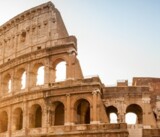
The Colosseum
|
"Step into history at the Colosseum, Rome's iconic amphitheater. A symbol of grandeur and gladiator glory, this marvel captivates with its colossal architecture and echoes of ancient spectacles." |
Media Room |
Community |
Communicate |
Agent Contact
Owner Contact
The Colosseum, a monumental symbol of ancient Rome, stands as an enduring testament to the grandeur of Roman engineering and culture. Located in the heart of Rome, Italy, this awe-inspiring amphitheater is a marvel of architectural ingenuity and historical significance.
History: Constructed under the Roman Empire, the Colosseum, also known as the Flavian Amphitheatre, was commissioned by Emperor Vespasian in AD 70-72 and completed by his successor Titus in AD 80. Its purpose was to host gladiatorial contests, public spectacles, animal hunts, and mock sea battles, captivating audiences numbering up to 80,000 spectators.
Architecture: The Colosseum is an engineering marvel, featuring an elliptical shape with a circumference of 527 meters and a height of 48 meters. Built using travertine limestone, tuff (a type of volcanic rock), and brick-faced concrete, its tiers once held a complex system of seating, dividing the audience according to social class. The arena floor, covered by sand, concealed a labyrinth of tunnels and chambers that housed animals, gladiators, and stage props.
Significance: As a symbol of Roman power and entertainment, the Colosseum has endured centuries of history, witnessing the rise and fall of empires. Despite the damage inflicted by earthquakes and stone-robbers over time, the Colosseum remains an iconic representation of ancient Rome's architectural prowess.
Today: Declared a UNESCO World Heritage Site, the Colosseum attracts millions of visitors each year who come to marvel at its imposing structure and immerse themselves in the rich history it represents. Restoration efforts continue to preserve this ancient wonder, allowing future generations to connect with the past and appreciate the cultural legacy it embodies.
Visiting the Colosseum is a journey back in time, where the echoes of gladiator battles and the cheers of the Roman crowd still resonate within its weathered walls, making it an enduring symbol of human achievement and endurance.
